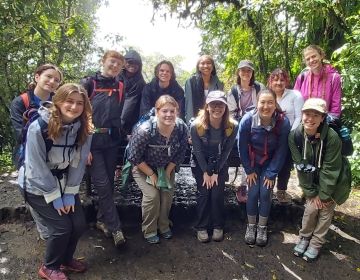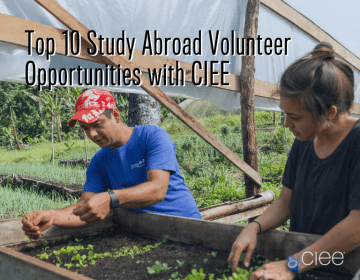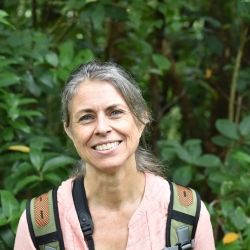Sustainability and the Environment: "The Mysterious Island"
Once they'd learned everything they could from the power plants and the volcanos on the mainland, the adventurers knew that their education would not be complete until they left their comfortable continent and lit out for the territories ahead of the rest, like old Huck Finn or something. Except in this case the territory they were lighting out for was called Isla Chira, and I don't think old Huck ever did make it out to the Gulf of Nicoya, which just happens to be where this little island here was located.
The water filling up the Gulf out here was the same water that the adventurers had walked beside just a few days earlier, when they had hiked the national park of Rincon de la Vieja and splashed around in that waterfall, remember? It was a good visual lesson about how water binds the world together; the little water molecules in the gulf have already seen way more of the world than we can ever hope to.
Well the adventurers loaded up their cargo and set out on their speedboats, hoping that there weren't any dinosaurs swimming around in the gulf out here like the third Jurassic Park movie implied there might be.
Meg, Chandler, and Emma momentarily get trapped in Channy's hula-hoop before departing
Isla Chira is an old-school island that's been able to pretty much avoid hard-core urbanization and commercialization and all that jazz; the economy of the island isn't driven by tourism but instead by the traditional occupations of fishing and clamming, which is pretty cool. Out here, the adventurers were going to get a good look at what Costa Rica was like before the ecotourism boom.
The place that they'd be staying on the island was called La Amistad, and it had a pretty cool story too. The three ladies who ran the place had built the entire compound with their own two hands (or six hands, since there were three of them I guess), even though a lot of the men on in the community weren't too stoked about them doing what was traditionally male work. They overcame prejudice, negativity, and no support from the community to do what they loved, and built the whole place by themselves. It was pretty darn inspiring, man.
La Amistad does everything it can to be as sustainable as possible, and that includes cooking on these nifty solar cookers, which you can find a picture of below. These guys look kind of like giant rounded mirrors, and they use the heat they absorb from the sun to cook delicious food for hungry adventurers.
Not a good place to try to dry your socks
The whole of Isla Chira was covered in a dry forest, and so the ladies knew they had to be pretty cautious with their little solar cookers, not leave them pointed at some piles of dead leaves or anything, just to make sure the whole place didn't go up like a box of matches.
This dry forest was a whole lot different than the wet cloud forest the adventurers had left behind in misty Monteverde, so it was cool to get to see this different ecosystem; there's a huge range of environments within a country smaller than some US states.
In the afternoon of the day of their arrival on the mysterious island, Adam informed the students that they weren't really here to learn about the dry forests, but instead to immerse themselves in the study of the mangroves. Mangrove ecosystems are some of the most interesting and unique ecosystems on the planet, and they are a cradle for life but are rapidly disappearing from the earth. The adventurers were pretty excited to get to journey into this endangered ecosystem to take a look for themselves.
Even reading the tide charts can't prevent a couple flooded crossings
Adam told the adventurers that mangroves had once covered 75% of tropical coastlines, but half of the mangrove forests in the world have been destroyed in the past 30 years. Costa Rica is doing okay, implementing protection laws and seeing regrowth since the 80s and 90s, but these ecosystems are still in danger when you consider how important they are to biodiversity.
If you're wondering what a bunch of stupid mangroves have to do with biodiversity, listen to this: first of all, they're an important buffer for storms, preventing violent landfall and protecting the animals that live within them and preventing the erosion of the land that lies behind them. They are also a vital part of the food chain; they produce carbon, making them a base of food webs for many different species. Additionally, mangroves serve as the nurseries of the ecosystem; for example, 80% of important fish species in Florida need mangroves to survive. So next time you see a mangrove, don't yank it out of the ground or something; give it a thumbs-up and tell it it's doing an awesome job out there.
The adventurers are seeing what they can learn from these wise old mangroves
For Adam's mangrove day, he taught the students all about the different types of mangroves and how to recognise them, as well as the different ways they fit into the ecosystem. In a normal biology class in the states, unless you lived in the everglades or something, you would have had to try to ID these cool mangroves based on pictures from a book, but since the adventurers just happened to be on the pacific coast of Costa Rica, they got to go out and pick these bad boys out of a line-up.
Leah tests whether or not mangrove leaves are good for eating
During the middle of their mangrove investigations, the adventurers stumbled upon a disturbing turn of events. Wouldn't you know it, they ran right into a poacher who'd been out trawling and gotten chased by the coast guard, and who'd come into the mangroves to hide out and escape the chase. If you think all of that sounds interesting, then just keep reading, cause you can learn a whole lot more about poachers and sustainable fishing a little later on in this cool blog post.
The old poacher guy got out of there when he figured that the coast was clear, and he left a bunch of the dead fish and jellies that had gotten caught in his trawling net just laying there on the beach. That's the problem with trawling-- nets don't discriminate, and you end up catching a lot of stuff you have no use for, little creatures that just end up in the crossfire. Not very sustainable, is it?
The adventurers were beautiful souls and spent a while figuring out which jelly fish were still alive and returning them to the water, and they were super happy that they did it because they saved a lot of little lives, even if those same jellies might have stung them a few minutes later when they were swimming around.
Sometimes in life, you just have to save as many jellies as you can
Once they'd done their good deed for the day, the adventurers journeyed into the heart of the mangrove forest to have a lecture with Adam, and of all the classrooms they had ever been in, this was maybe the most interesting.
Sadia liked the muddy mangrove ecosystem so much, she almost stayed forever
As the adventurers headed back out the the beach, they looked over there shoulders and got a pretty good visual aid for the importance of the mangrove ecosystem. While the forest was dry and brown cooking underneath the hot sun, the mangroves were green and wet and the perfect shelter for the little critters that made Isla Chira their home.
The mangroves are wearing a dry, brown hat
Nights on Isla Chira were pretty chill for the most part; the adventurers got to sit around on their porches reading or playing games or telling each other stories or something, but one night they got tired of all that sitting, and so they walked down the road a little but and found a soccer field to challenge some of the local chicos to a game of futball. It was a pretty great game, and nobody even got injured, except the photographer a little, but he doesn't count.
Julia's going, "Hey, whoa, I don't want any trouble now..."
In the morning, the adventurers got to go out fishing with some of the local fishermen to see what this whole fisherman's lifestyle was all about. They used shrimp for bait and got to test their skills and find out if they could make it as fishermen.
Aislyn keeps an eye out for crocs at the front of the boat. She would go, "Croc! No wait, sorry, log. No wait, croc!"
Erica proves she is not to be trifled with, especially if you're a fish
Now a number of years ago, the fisherman of Isla Chira started to realize that the fish that they needed to make their living on were starting to disappear, an effect of over-fishing and unsustainable fishing methods like trawling and long-line fishing. If you're wondering what trawling is, it's when you drag a net along the water behind the boat, and just catch whatever happens to be swimming around in there. Long line fishing is when you have a super long line with about a million hooks, and then you just reel it in and collect everything. The problem with these two methods is that they don't discriminate. You could just as easily catch a sea turtle as a seabass, which ends up decimating the ecosystem and leading to over-fishing and local extinction.
So this was no good, and for a while a lot of the fish that these fishermen relied on to make a living were starting to disappear, so a bunch of them got together and and said, "Listen guys, this is no good, we gotta do something about this," except it was in Spanish of course, so it was more like, "No bueno. Que hacer?"
Eventually, these guys formed a Fisher's Association, and they came up with a bunch of guidelines to promote sustainable fishing and preserve their of their way of life. They set regulations about hook size and fishing methods, and selected an area of water to be preserved, where trawling wouldn't be allowed and fishers in that area would have to obey the rules for the good of the community and the longevity of their livelihood.
Now most of the time, people follow the rules just fine, but every now and then there's some folks who like to try to slip below the radar and use these contraband methods inside the protected zone. These old scallywags are called poachers, and they're a real problem for the community, because they threaten the fragile balance of the ecosystem for a quick buck. The problem is, these guys aren't secret masterminds coming in from foreign lands; they're neighbours and members of the community, trying to make a living for themselves and their family. It's all grey areas man, it's tricky stuff.
To prevent the poachers from taking advantage of the protected area, members of the Fisher's Association take turns going out in boats and patrolling for poachers every night. These adventurers thought that sounded like an interesting time, so they got to spend one night going out there on patrol for poachers with the fishermen.
The adventurers ate dinner at the Fisher's Association to get them all fuelled up for a night patrol
It was a memorable experience. The adventurers didn't find any poachers, which is probably good, but they got to boat around beneath the stars and dip their hands into the wake where bioluminescence sparked and danced like fairy dust or moving stars under the water, the great kings of the past. They spoke to the fishermen who would spend the rest of the night til dawn out here on the water, and he told them that the hardest part about the night patrols was the loneliness, being out there in all that emptiness and all that dark and trying to stay awake as your body and the slow waves tried to rock you off to sleep.
After about a half an hour of patrol, the fisherman guide pulled his boat up onto a secret sandbar in the middle of the gulf, and the adventurers got to get out and walk on smooth sand in the middle of the ocean, with great chasms of water falling off below them on either side.
Then the adventurers returned safely to the island, while the old fisherman turned his motor and headed back out into the night.
A successful super-adventure
With the fishermen all covered, it was time to learn about the Clammer's Association. While the fishermen consider themselves fighting a hard battle, but overall pretty successful in their endeavours, the women of the Clammer's Association consider their endeavours to have largely failed. Here's the story.
in 1999, 20 women started the organisation in response to a lack of work opportunities in the community for women, so they originally met to find work for themselves. They started the clammers association as a way to sustainably harvest clams-- enough to support themselves, but not so many as to damage the environment or risk the future population of clams. The organisation planted 15,000 clams per week in the early days, then waited two years to harvest them until they were 8cm, an appropriate size to harvest. They only took the big clams, allowing the small ones to remain and continue to grow.
The women were extremely successful in their endeavours, which got the attention of the media. After being featured in the news, the secret kind of got out, and a ton of outsiders came in and sacked the breeding ground, taking all the clams they could carry and not worrying about how that would affect the population and future yields, since they weren't locals. Due to the culture of the island and the time period, the women received no help from men in guarding the protected area and confronting the poachers, since the men considered clamming "women's work." Trying to protect the area from poachers became so dangerous that women started abandoning the organisation, and even reaching out the the media had no effect. There should have been legal protection for the protected area, but neither Incopesca nor Minae, the two government regulating organisations, stepped up.
Now, the remaining women are small in number and have had to reduce their conservation focus, and clams in the area are becoming extinct. The adventurers went out and had an interview with Vilma, who has been the president of the organisation for 16 years, and she told them all about the history of the association, and then she was nice enough to take the adventurers out to the mangroves and teach them how to clam, and that was pretty cool.
Now it does get pretty muddy in there inside those mangroves, so the adventurers got to wear some nifty gear, like cloth sacks for pants, spare t-shirts, and elegant gloves for reaching down into the mud.
Emma and Eilish dig their new threads
Once they had their sweet gear on, the adventurers headed off into the mangroves to try to find themselves some sweet clams. Now you have to understand walking around in there can get a little difficult, you know?
Morgan decided to lay down and take a rest in-between all her clam-finding
Tessa's got a monster clam, what a madman
Of course when you get college students that close to basically an unlimited supply of mud, a good old fashioned mud fight is bound to break out sooner or later. This one broke out sooner.
Aislyn has the high ground, basically a bird's nest, so she's invincible
A small bit of the video evidence recovered from the war photographer's muddy body:
Well they learned a little about clamming and a lot about having mud fights, so it was just about the most productive day ever, you know?
Isla Chira was definitely a beautiful place, and the kids thought that maybe they could just stay there forever, even though they knew they couldn't because their dogs and cats would miss them way too much.
They only had a few days left here, but one of those days was Bird Day, and that was bound to be exciting. Stay tuned for rare bird sightings, brushes with American Crocodiles, and much more island culture in the next dispatch from the island.
The mud-warriors make it safely to the beach
Related Posts

Happy Earth Day: Today and Every Day
Happy Earth Day! Every April 22, this global event comes around to remind us how precious our planet is, what sustainable efforts we can make to protect Earth, and that... keep reading

Costa Rica vs. Argentina: Which is Better for Study Abroad?
Imagine yourself sipping mate in a bustling Buenos Aires café or lounging peacefully in a hammock overlooking Costa Rica's lush rainforests. These contrasting scenes represent just a glimpse of the... keep reading

Top 10 Study Abroad Volunteer Opportunities with CIEE
Have you ever wondered if you could volunteer abroad? Perhaps you're looking into study abroad programs that provide international volunteer opportunities. If you’re itching to study abroad and truly make... keep reading
